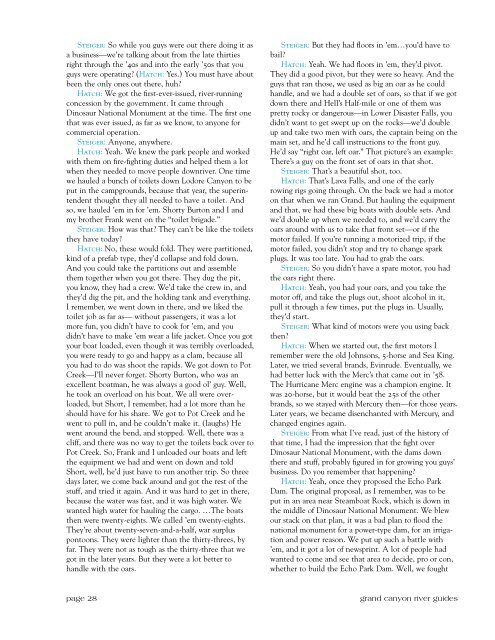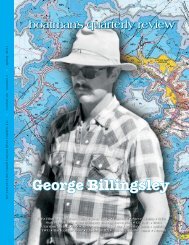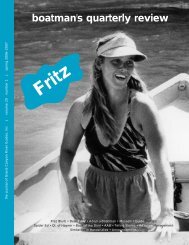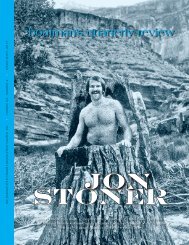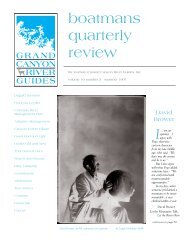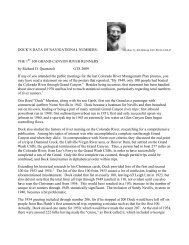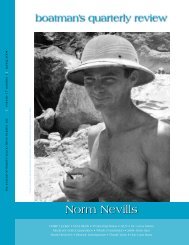summer 03 / 16:2 - Grand Canyon River Guides
summer 03 / 16:2 - Grand Canyon River Guides
summer 03 / 16:2 - Grand Canyon River Guides
- No tags were found...
You also want an ePaper? Increase the reach of your titles
YUMPU automatically turns print PDFs into web optimized ePapers that Google loves.
Steiger: So while you guys were out there doing it asa business—we’re talking about from the late thirtiesright through the ’40s and into the early ’50s that youguys were operating? (Hatch: Yes.) You must have aboutbeen the only ones out there, huh?Hatch: We got the first-ever-issued, river-runningconcession by the government. It came throughDinosaur National Monument at the time. The first onethat was ever issued, as far as we know, to anyone forcommercial operation.Steiger: Anyone, anywhere.Hatch: Yeah. We knew the park people and workedwith them on fire-fighting duties and helped them a lotwhen they needed to move people downriver. One timewe hauled a bunch of toilets down Lodore <strong>Canyon</strong> to beput in the campgrounds, because that year, the superintendentthought they all needed to have a toilet. Andso, we hauled ’em in for ’em. Shorty Burton and I andmy brother Frank went on the “toilet brigade.”Steiger: How was that? They can’t be like the toiletsthey have today?Hatch: No, these would fold. They were partitioned,kind of a prefab type, they’d collapse and fold down.And you could take the partitions out and assemblethem together when you got there. They dug the pit,you know, they had a crew. We’d take the crew in, andthey’d dig the pit, and the holding tank and everything.I remember, we went down in there, and we liked thetoilet job as far as— without passengers, it was a lotmore fun, you didn’t have to cook for ’em, and youdidn’t have to make ’em wear a life jacket. Once you gotyour boat loaded, even though it was terribly overloaded,you were ready to go and happy as a clam, because allyou had to do was shoot the rapids. We got down to PotCreek—I’ll never forget. Shorty Burton, who was anexcellent boatman, he was always a good ol’ guy. Well,he took an overload on his boat. We all were overloaded,but Short, I remember, had a lot more than heshould have for his share. We got to Pot Creek and hewent to pull in, and he couldn’t make it. (laughs) Hewent around the bend, and stopped. Well, there was acliff, and there was no way to get the toilets back over toPot Creek. So, Frank and I unloaded our boats and leftthe equipment we had and went on down and toldShort, well, he’d just have to run another trip. So threedays later, we come back around and got the rest of thestuff, and tried it again. And it was hard to get in there,because the water was fast, and it was high water. Wewanted high water for hauling the cargo. …The boatsthen were twenty-eights. We called ’em twenty-eights.They’re about twenty-seven-and-a-half, war surpluspontoons. They were lighter than the thirty-threes, byfar. They were not as tough as the thirty-three that wegot in the later years. But they were a lot better tohandle with the oars.Steiger: But they had floors in ’em…you’d have tobail?Hatch: Yeah. We had floors in ’em, they’d pivot.They did a good pivot, but they were so heavy. And theguys that ran those, we used as big an oar as he couldhandle, and we had a double set of oars, so that if we gotdown there and Hell’s Half-mile or one of them waspretty rocky or dangerous—in Lower Disaster Falls, youdidn’t want to get swept up on the rocks—we’d doubleup and take two men with oars, the captain being on themain set, and he’d call instructions to the front guy.He’d say “right oar, left oar.” That picture’s an example:There’s a guy on the front set of oars in that shot.Steiger: That’s a beautiful shot, too.Hatch: That’s Lava Falls, and one of the earlyrowing rigs going through. On the back we had a motoron that when we ran <strong>Grand</strong>. But hauling the equipmentand that, we had these big boats with double sets. Andwe’d double up when we needed to, and we’d carry theoars around with us to take that front set—or if themotor failed. If you’re running a motorized trip, if themotor failed, you didn’t stop and try to change sparkplugs. It was too late. You had to grab the oars.Steiger: So you didn’t have a spare motor, you hadthe oars right there.Hatch: Yeah, you had your oars, and you take themotor off, and take the plugs out, shoot alcohol in it,pull it through a few times, put the plugs in. Usually,they’d start.Steiger: What kind of motors were you using backthen?Hatch: When we started out, the first motors Iremember were the old Johnsons, 5-horse and Sea King.Later, we tried several brands, Evinrude. Eventually, wehad better luck with the Merc’s that came out in ’58.The Hurricane Merc engine was a champion engine. Itwas 20-horse, but it would beat the 25s of the otherbrands, so we stayed with Mercury then—for those years.Later years, we became disenchanted with Mercury, andchanged engines again.Steiger: From what I’ve read, just of the history ofthat time, I had the impression that the fight overDinosaur National Monument, with the dams downthere and stuff, probably figured in for growing you guys’business. Do you remember that happening?Hatch: Yeah, once they proposed the Echo ParkDam. The original proposal, as I remember, was to beput in an area near Steamboat Rock, which is down inthe middle of Dinosaur National Monument. We blewour stack on that plan, it was a bad plan to flood thenational monument for a power-type dam, for an irrigationand power reason. We put up such a battle with’em, and it got a lot of newsprint. A lot of people hadwanted to come and see that area to decide, pro or con,whether to build the Echo Park Dam. Well, we foughtpage 28grand canyon river guides


